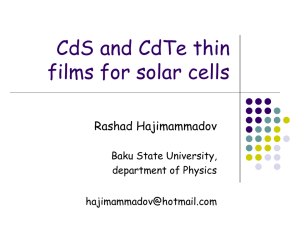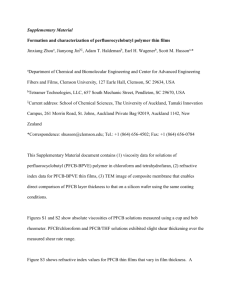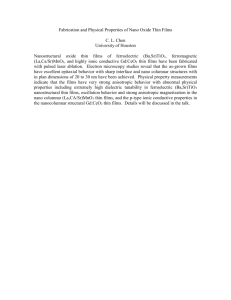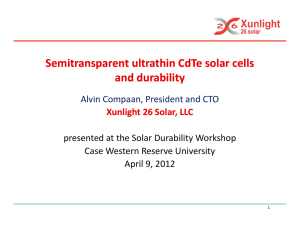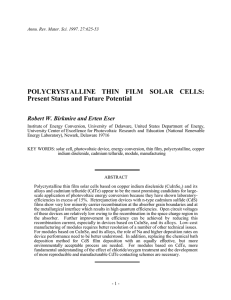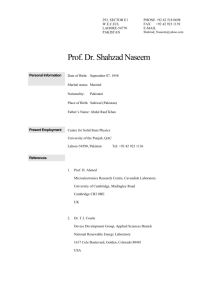STUDIES ON THE EFFECT OF BUFFER LAYERS IN ENHANCING
advertisement
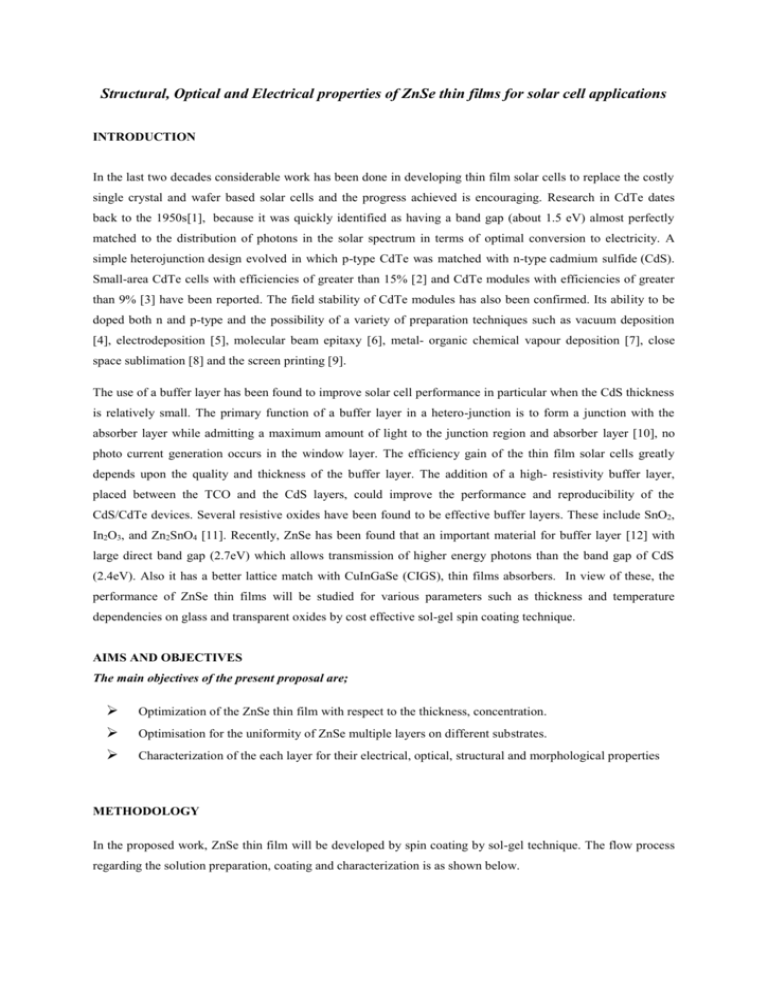
Structural, Optical and Electrical properties of ZnSe thin films for solar cell applications INTRODUCTION In the last two decades considerable work has been done in developing thin film solar cells to replace the costly single crystal and wafer based solar cells and the progress achieved is encouraging. Research in CdTe dates back to the 1950s[1], because it was quickly identified as having a band gap (about 1.5 eV) almost perfectly matched to the distribution of photons in the solar spectrum in terms of optimal conversion to electricity. A simple heterojunction design evolved in which p-type CdTe was matched with n-type cadmium sulfide (CdS). Small-area CdTe cells with efficiencies of greater than 15% [2] and CdTe modules with efficiencies of greater than 9% [3] have been reported. The field stability of CdTe modules has also been confirmed. Its ability to be doped both n and p-type and the possibility of a variety of preparation techniques such as vacuum deposition [4], electrodeposition [5], molecular beam epitaxy [6], metal- organic chemical vapour deposition [7], close space sublimation [8] and the screen printing [9]. The use of a buffer layer has been found to improve solar cell performance in particular when the CdS thickness is relatively small. The primary function of a buffer layer in a hetero-junction is to form a junction with the absorber layer while admitting a maximum amount of light to the junction region and absorber layer [10], no photo current generation occurs in the window layer. The efficiency gain of the thin film solar cells greatly depends upon the quality and thickness of the buffer layer. The addition of a high- resistivity buffer layer, placed between the TCO and the CdS layers, could improve the performance and reproducibility of the CdS/CdTe devices. Several resistive oxides have been found to be effective buffer layers. These include SnO2, In2O3, and Zn2SnO4 [11]. Recently, ZnSe has been found that an important material for buffer layer [12] with large direct band gap (2.7eV) which allows transmission of higher energy photons than the band gap of CdS (2.4eV). Also it has a better lattice match with CuInGaSe (CIGS), thin films absorbers. In view of these, the performance of ZnSe thin films will be studied for various parameters such as thickness and temperature dependencies on glass and transparent oxides by cost effective sol-gel spin coating technique. AIMS AND OBJECTIVES The main objectives of the present proposal are; Optimization of the ZnSe thin film with respect to the thickness, concentration. Optimisation for the uniformity of ZnSe multiple layers on different substrates. Characterization of the each layer for their electrical, optical, structural and morphological properties METHODOLOGY In the proposed work, ZnSe thin film will be developed by spin coating by sol-gel technique. The flow process regarding the solution preparation, coating and characterization is as shown below. Zinc Acetate (0.1-0.5M) + 2-Methoxyethanol Selenic Acid (0.1M) + Ammonium Hydroxide 10min stirring Acetic Acid (Catalyst) 12hrs stirring ZnSe Solution Aging (12hrs) Spin Coating (3krpm for 60sec) Characterizatio ns XRD, SEM, UV-VIS SPECTROPHOTOMETER Samples will be characterized for structural studies using X-Ray Diffractometer (XRD). From the XRD results, studies will be made on their nature and formation of the film such as amorphous and crystalline. Morphological studies will be carried out using SEM (Scanning Electron Microscopy) or AFM (Atomic Force Microscopy) images. Structural and morphological studies will be carried to understand the films for their uniformity, continuity, grain size, etc. The electrical properties will be studied using 4 probe technique. Optical characteristics of the prepared films will be studied using double source UV-VIS-NIR spectrophotometer. The optical properties such as absorption, transmittance, reflectance, band gap energy will be studied which is useful for device applications. The thickness and refractive index can be determined by both envelope technique using reflection spectrum and by using ellipsometer. REFERENCES [1] [2] [3] [4] [5] [6] [7] [8] [9] [10] [11] [12] D. A. Jenny and R. H. Bube (1954). "Semiconducting CdTe". Phys. Rev. 96: 1190. doi: 10.1103/Phys Rev.96.1190 J. Britt and C. Ferekides, Appl. Phys. Lett. 62, 2851 (1993). K. Zweibel, H. Ullal, and B. von Roedern, 25th IEEE Photovoltaic Spec. Conf., 745 (1996). W. Song, D. Mao, Y. Zhu, J. Tang and J.U. Trefny, 25th IEEE Photovoltaic Specialist Conf., (1996) 873. A.N. T_ywari, H. Zagg, S. Blunier, K. Kessler, C. Maissen and J. Masek, Int. J. Solar Energy, 12 (1992) 187. Rohatgi, Int. J. Solar Energy, 37 (1992) 37. Aguilar, A.I. Oliva, R. Castro-Rodriquez, J.L. Pena, Thin Solid Films, 293 (1997) 149. Clemminck, M. Burgelman, M. Casteleyn and B. Depuydt, Int. J. Solar Energy, 12 (1992)67. G.P. Naumov and O.V. Nikolaev, Sov. Phys. Solid State, 3 (1962) 2718. M. Powalla, B. Dimmler, R. Schaeffler, G. Voorwinden, U. Stein, H.-D. Mohring, F. Kessler, D. Hariskos, Proc. 19th European Photovoltaic Solar Energy Conference Paris, France, (2004). Shimizu A, Chaisitsak S, Sugiyama T, Yamada A, and Kongai M,. Zinc-based buffer layer in the Cu(InGa)Se2 thin film solar cells. Thin Solid Films, 361-362: 193-197 (2002). www.elsezier.com/locate/issn 00406090 2002: 193-197. K. Bothe, G. H. Bauer, and T. Unold, Thin Solid Films, 403–404, 453–456 (2002).


